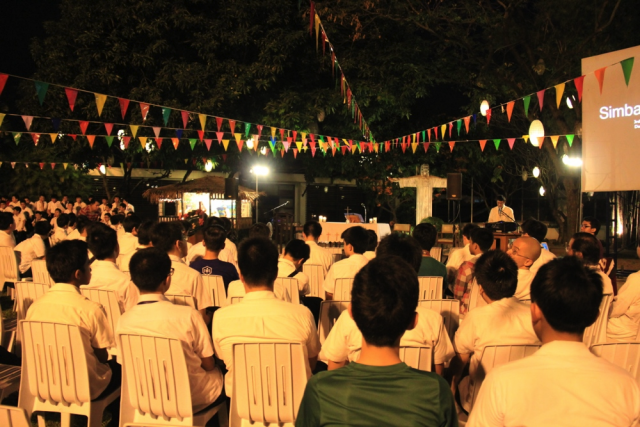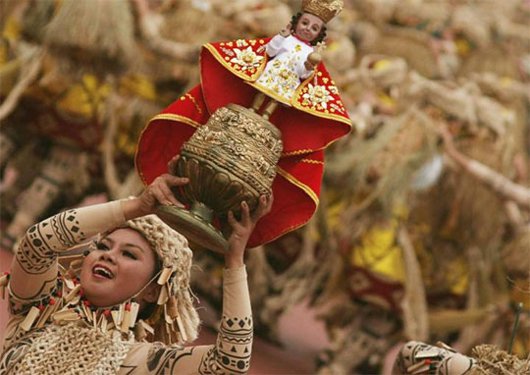French Jesuit Pierre de Charentenay has just completed a year in the Philippines. He offers here his impressions of faith as it is practised in the Philippines. He considers how the numerous massive processions and other major religious practices in the country can be seen as authentic expressions of faith. He begins by considering the four known ways of living the faith: the simple faith, the faith of intelligence, the faith of the heart and the faith of the modern Christian. He then looks at the common characteristic of these religious practices – all these events involve a physical commitment of devotees who participate in great numbers together as a community of faith.
Fr Charentenay explains that devotees build faith by physical commitment, build the community by being there together, and build a way of living together as Filipinos. The Filipino version of faith entails a real physical or bodily effort from each member of the community similar to making a pilgrimage but with a community density dimension. He explores threats to these religious practices and concludes that the Filipino practice of faith is alive and well despite its limitations.
Read Fr Charentenay’s essay below.
A Filipino Practice of Faith
The many massive processions organized in the Philippines, in Naga, Quiapo or Cebu, their intensity and the crowds they attract are sometimes described by external observers as expressions of popular religion (with a slight depreciative accent), a deformation of faith, or a new expression of fanaticism. Whatever these opinions, these religious manifestations are a reality which is part of the cultural and religious landscape of the Philippines.
The interpretation of this unique phenomenon is not easy. Since we make the hypothesis that they are true expression of faith, we have to clarify what kind of faith might be expressed here.
Faith has several ways of expressing itself. It depends on the local history of the church, the national tradition, a whole set of cultural elements which make the expression of faith unique in some places. We will see how different traditions regard the meaning and the expression of faith. Then we will be able to look at the way the Philippines has found a specific way of expression of faith. Let us first consider four main and already known ways of living the faith so far: the simple faith, the faith of intelligence, the faith of the heart and the faith of the modern Christian.
1 The Simple Faith
This is the strong faith of ordinary people, workers, farmers, employees, all men and women of good faith who do not have the words or the will to define their faith. They just practice it. They live with it all along their life without asking questions.
This faith is not threatened or destroyed by any external event or personal difficulties like death or accident in the family. These people are immune from the consequences of change of civilization or ways of living. Their faith is part of their life forever, and they will not lose it, by any event. It is so deeply rooted in them that nothing can take it away.
They are quite individualistic since they are very independent from external events. The simple faith does not communicate itself outside. There is no common practice, no community exchanges behind this strong faith. Each person lives her faith the way she wants and how she can.
Less and less people are living their faith that way, because of the difficulty of being independent from external influences from culture, media, communication, trips, and so on. No one is isolated in one’s practice anymore.
2 Blaise Pascal or the Faith of Intelligence
This model of the faith of intelligence is well represented by a French of the 17th century, famous for his hate of the Jesuits but also for his spiritual sense and his capacity for writing. He was impressed by, and afraid of, the infinite space out there. He did not have a simple and straightforward faith, but a very intellectual one: the world being what it is, he would bet on the existence of God. Nothing can be certain, but it is worth betting on the presence of God in the world. What could be more intellectual than that?
This type of faith is strong and articulate when one remains in the spirit of God, as he said in his Thoughts, avoiding the “distractions”: “All the evil of the world is summed up by the fact that one cannot remain quiet and still in his room”. The problem is that the world today is made of distractions, from the society of consumption to the last electronic instruments, the desire for leisure, of seeing the world, of being connected with everyone. It becomes difficult to concentrate one’s life on an objective.
The second problem is linked to the disappearance of transcendence in the modern developed world. The modern citizen is preoccupied by his or her day to day life, insurance for the future, health and well-being. He or she does not see the infinite space out there as a question. There is no more space in the mind for questions about the source of being and life. So one can end up without questioning oneself, since one has no particular sense of anything existing outside of oneself. The intellectual faith of Pascal is in danger in the modern world.
3 Mother Teresa or the Faith of the Heart
We know now through her correspondences that Mother Teresa had been left in the darkest night of faith most of her life. She did not see God, she could not say anything about him, she did not experience his presence.
But she had the faith of the heart of Jesus, a heart given to the poor ad infinitum, a heart who would love the very many poor of this world. This made her choose service to the dying in the worst place of the world, in Calcutta, decades ago. Those who did not exist for anybody, who ended their life on the sidewalk, became her privileged friends in the Lord.
Her faith in God was linked to her love for the poor because of the love of Christ for the poor. This faith of love is more easily understood by modern people, because it does not need the faith in transcendence. It can be exercised from inside the world on the level of human feeling, of attention to one’s neighbor, of applying the golden rule: “Do to others what you would like them to do for you”. This is the Gospel, and the whole gospel, with Matthew 25 in the background. With the humanitarian movement, the modern world has launched a great series of attempt to love others by helping and supporting them in all circumstances. There is here faith in human beings, not in God, while Mother Teresa, although unable to see God, would refer to him constantly. Humanitarian feelings are not religious, even if they are generous. But they are grounded in strong values of human right and human dignity which can maintain a strong level of commitment from even non-religious people. Religious or not, people can dialogue on the basis of love of others. The faith of the heart can be shared even if there is no faith.
4 The Faith of the Modern Christian Hero
Another model is now present in secularized countries of Europe, the Christian believer who has resisted all elements of secularization, power of science, leisure preoccupations, modern pleasure, insurances by the state, etc. Beyond all the changes and the worldliness of daily life, he discovers and lives the reality of faith. While the culture is totally secularized, and transcendence has disappeared from the public sphere, the believer has made a choice: that of living for Christ. Beyond all temptations, he is like a hero of modern time who made the choice of faith although the whole modern civilization is turning its back to it.
As a matter of fact, this transformation is not specific to the western world; it is also true in all regions of the world where development has arrived and has given other preoccupations and distractions to inhabitants, be they the business people in Abidjan or the students in Mexico, Mumbai or Manila. They are all taken by the secularized movement, and their attention has been diverted from their faith. They have many other possibilities than following the religious belief and they actually do it. Vocations to the priesthood or religious life are coming in much smaller number, like in the developed world. The globalization of unbelief is on the way at different paces. It demands now a strong personal decision to live one’s faith in this context. You have to be a real hero to maintain this life.
A Filipino Practice of Faith
In the Philippines, another way of practicing one’s own belief is experienced through many great events, from the novena of Simbang Gabi (Dawn Masses) before Christmas in the whole
Simbang Gabi for instance has disappeared for some years, prohibited by Rome which was worried about non-religious transformations of the event. But eventually, it re-emerged in the Philippines, being now a well-known practice of Masses celebrated as early as 3:00 or 4:00 am for nine days before Christmas. Crowds flock to churches all over the country, as friends and Christians together.
The procession of the Black Nazarene in Quiapo on January 9th has never been so well-attended as now, at the beginning of the 21st century, with over 3 million people. The same can be said about the procession of the Santo Niño in Cebu on the third weekend of January.
What is the common characteristic of these events? They involve a physical commitment of devotees who participate in great numbers together as a community of faith. People must get up early in the morning for nine days for the Simbang Gabi, they must walk up to 18 hours to Quiapo, or 5 hours in Cebu after they had been following the fluvial parade since the same morning. This does not mean that the heart or intelligence is absent, but they are not the basis of that faith: here the devotee is totally physically involved with others in the practice. He/she is even exhausted by such act of faith. He/she shares the concentration of people by standing for hours together in a very dense togetherness. He/she builds faith by physical commitment, he/she builds the community by being there together, he/she builds a way of living together as Filipinos. Being together for such an effort is a cement, as it were, for the community and is a sign of one’s identity.
This physical and communal commitment is the condition for the answer to the grace or petition that the devotee has been asking. It guarantees a response from God. It is like the demand that the poor widow made to the unjust judge who finally answered the demand because he got tired of the repetition and of her presence.
The attempt to organize more comfortable forms of these practices show that the faith is not understood in its strong practical involvement. So the practice of Simbang Gabi on the night before makes the practice easier and more comfortable: but it loses part of its value because the commitment of the devotee has been softened and eased. It becomes a more individual practice chosen by people who do not share the same community feeling. The Filipino version of faith entails a real physical or bodily effort from each member of the community.
That is why these practices are so appealing to young people who might have no intellectual sense of faith or do not know how to practice it as charity. It appeals to them because they know their identity lies somehow in that practice. The challenge of being entirely committed to it by one’s own bodily involvement with friends and companions makes it more challenging and real.
It has some relation to the past practices of pilgrimage where faith was expressed through the reality of walking for thousands of miles, like St. Ignatius of Loyola going to Jerusalem, or like today when thousands of people walk to Santiago de Compostela. This is an expression of faith. But the community density dimension is missing, while it is essential to the Filipino version of faith.
This physical and community experience does not exist anywhere else anymore. Even in Spain, Portugal or Mexico, the density of the population does not reach that level in Guadalupe or in Fatima. Processions are important but not at that level. What is unique in the Philippines is also the repetition of the phenomena in different places: Simbang Gabi, which has disappeared everywhere else, is celebrated all over the country in overflowing churches. This is the will of lay people, not of the hierarchy: the whole Black Narazene procession is managed by lay people who decide where they want to go, how and when.
Is this faith? Clearly yes, because it is an expression of belief in God, in the Cross, in the Child Jesus to which the crowd gives its confidence and directs its questions and prayers: God will answer them, console them, welcome them.
Can it be transmitted? It is already transmitted by the presence of many young people. There is nothing intellectual here. It is not the fruit of a decision after a moment of freedom and of distance: the young devotee follows his or her brothers and sisters in the community. The transmission is working.
This expression of faith is nevertheless threatened by many factors, like the different forms of faith, but differently. The more individualistic expression of faith puts a question to that physical and community practice. Each believer is looking for each one’s own comfort, each one’s best way of practicing the faith: that physical and community practice does not respond to an easy project. But so far, this expression is resisting the threat of individualism.
Does this faith relate in some way to the social reality? Does it produce some social effect? That is a very important question since the catholic faith has a strong relation to work for justice and attention to one’s neighbor and especially the poor in society. This vision of faith through popular manifestations does not seem to give this type of fruit. There is a de facto separation between the religious and social fields. That faith is not socially oriented, not in connection with social or personal morality. Corruption goes on, family violence goes on. Faith here is expressed beyond all ethical practices.
There is an attempt from the bishops to transform the strength of these manifestations into social action. In 2013, the Archbishop of Nueva Caceres has put all over the city the banners of the Peñafrancia with the inscription, “Growing in Catholic faith in Jesus Christ with Mary at the Service of Social Transformation”. Such a proposal is new, but it is less than evident, because the roots of the event are not related to society and it is not a reflexive faith, but an existential faith.
Could it be secularized? Maybe, it could become folklorized, transformed into a non-religious practice, just a cultural event. It is partly the case of Peñafrancia in Naga or with the Dinagyang festival in Iloilo where non-religious dimensions have been developed into a parade of schools
Another threat would be excessive commercialization. Tourist agencies, private contractors, all merchants know that these events attract a lot of people. What a good occasion to open a new market! Tourists could flock to observe the processions and participate in these movements. Participants would be pushed to transform these religious events into secular and spectacular dances like the festival of Rio since they are often already associated with a secular festival which follows the religious event. But this commercialization just remains a threat so far.
This Filipino practice of faith is well alive despite its limitations. It is not in danger of disappearance. The only shadow could be the possible commercialization and folklorization of these events.


